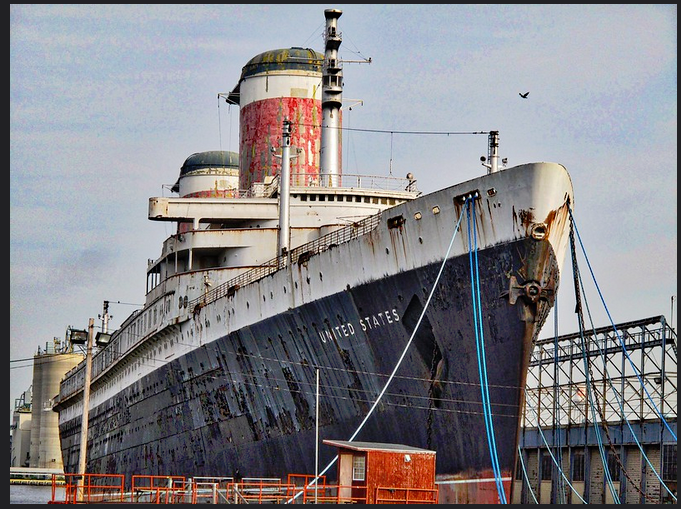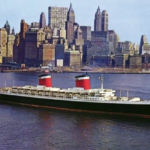The ocean liner S.S. United States was super sleek, extremely fast, and highly engineered…yet soon became obsolete due to air travel; cruise ships are now the royalty of the seas.
In today’s world, dominated by companies such as Facebook, Amazon, Apple, and Google, it’s easy to think they will be “forever” or at least for “the foreseeable future.” Of course, while history does not necessarily repeat itself, it also teaches lessons. The lesson here is that the foreseeable future may not be a long time, and the disruptive wheel of progress – regardless of whether you consider it good, bad, or both bad – keeps turning. Whether it’s in the retail domain with companies such as Sears Roebuck that have gone from dominance to having effectively “disappeared” over a long haul, or electronics leaders such as RCA that once were ubiquitous and leaders and are now just a marketing marque, the future is not a steady path.
Travel innovation “sinks” the ocean liner
The S.S. United States was a technical and commercial success, but only for a short period. What the sea couldn’t do, the jet aircraft did: make ocean liners no longer attractive in terms of travel time and cost. The need for ocean liners plying the route for North America to Europe began to evaporate with the introduction of commercial jet service (primarily the Boeing 707) in the 1960s. The numbers simply didn’t add up, and the ship was “retired” in 1969 while at the shipyard for major but routine maintenance. For business and other passengers, time on the ocean liner was “wasted” and lost — there were some shows, movies, and modest entertainment but no connectivity (phone, email, Internet) except for telegrams. In other words, it was time away and disconnected from work for both good and bad,
Since being taken out of service, ownership has passed through many entities, from cruise-ship lines hoping to somehow use it for unrelated commercial operations. Even if the ship were to be “restored,” there is little left to restore, as all the fittings and glamorous fixtures have been stripped out (many were sold as memorabilia to collectors and restaurants). The asbestos used throughout for fire safety has been stripped, thus causing more damage; the huge propellers are gone and now serve as high-end lawn ornaments at various institutions.
Over the years, there have been many proposals to somehow revive, preserve, or re-purpose the liner, including making it into a floating hotel similar to the Queen Mary in Long Beach, CA. None of these have worked out, and this marvel of engineering innovation sits decaying in a Philadelphia PA shipyard (Figure 1), costing the non-profit conservancy which presently owns it about $1 million/year. There are periodic efforts or intentions to have the ship restored and even returned to service. Still, the reality is that any such ship today will be very different than the original vessel. Sadly but probably unavoidable, it is likely that a scrap yard will be its next home—very tangible testimony to how a disruptive technology can from “nowhere” and soon make an engineering marvel obsolete in just a few years.

Today’s ocean-going passenger vessels are cruise ships, not ocean liners. The next part of this article looks at some of the engineering aspects associated with these behemoths.
E.E. World References
“Electric locomotives and catenary power systems – Part 1: basic functions”
“RCA & Color T.V.: A dominant company and standard, both now gone – Part 1”
“RCA & Color T.V.: A dominant company and standard, both now gone – Part 2”
External References
- Steven Ujifusa, “A Man and His Ship: America’s Greatest Naval Architect and His Quest to Build the S.S. United States,” Simon and Shuster, 2012
- Steven Ujifusa on William Francis Gibbs and His Ships (podcast and transcript)
- S.S. United States Conservancy , especially the link “The Ship”
- Vox Media, Curbed NY, “Deadline Looms for Historic Ocean Liner’s Move to Brooklyn”
- Cruise Maven, “Crystal Cruises Hopes to Return S.S. United States to Oceangoing Service” (2016)
- Cruise Mapper, “Cruise Ship Design Construction Building”
- Maritime Cyprus, “Ovation of the Seas Floated Out At Meyer Werft Shipyard”
- Cruise Mapper, “Deck Plans”
- Cruise Mapper, “Cruise Ship Engine Power, Propulsion, Fuel”
- The Telegraph, “13 things you didn’t know about cruise ship design”
- Interesting Engineering, “Understanding the Incredible Engineering of Cruise Ships”
- GCaptain, “Ship Engines – 7 Monster Engine Designs, Part 1”
- Carnival Corp., “The Design and Construction of a Modern Cruise Vessel”
- Martin Ottaway, “The Delightful Frustration of Cruise Ship Power Plant Design”






